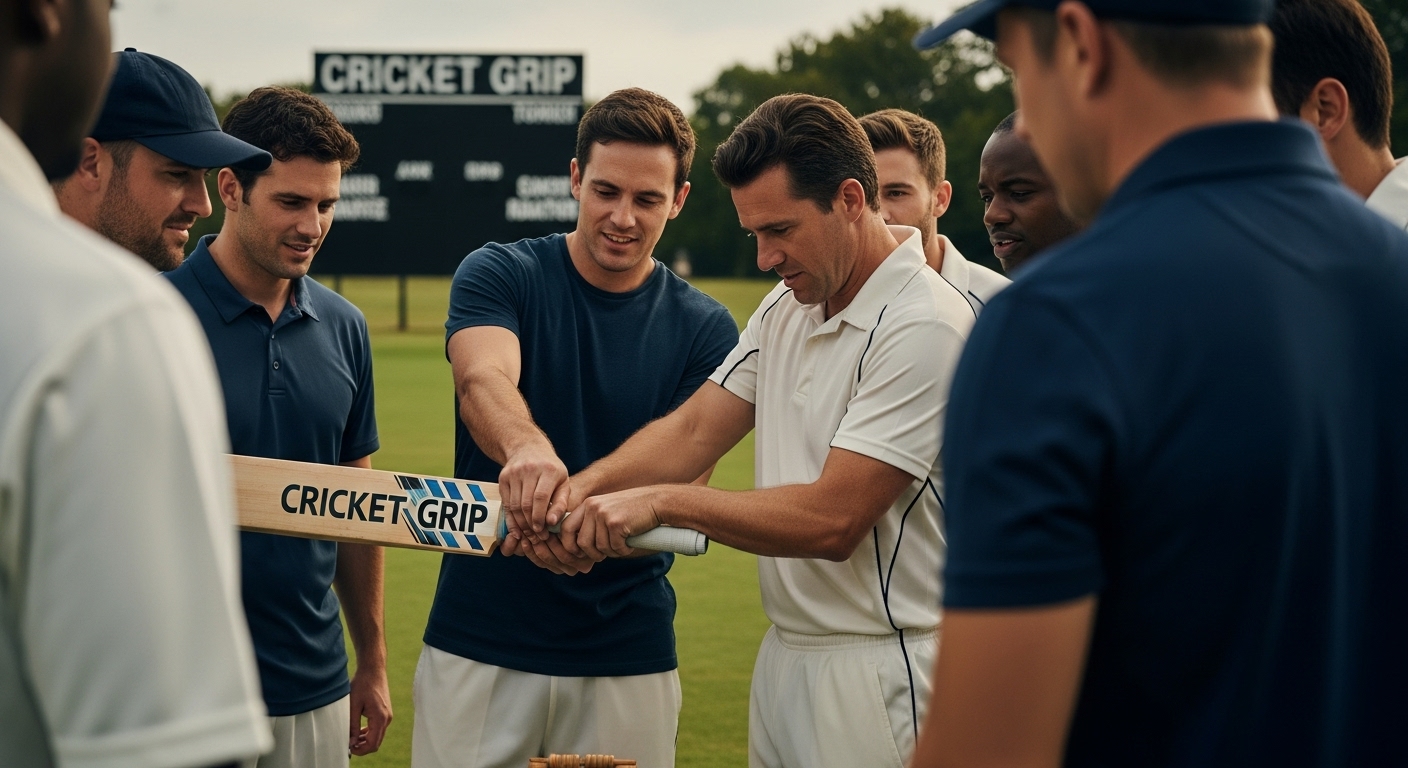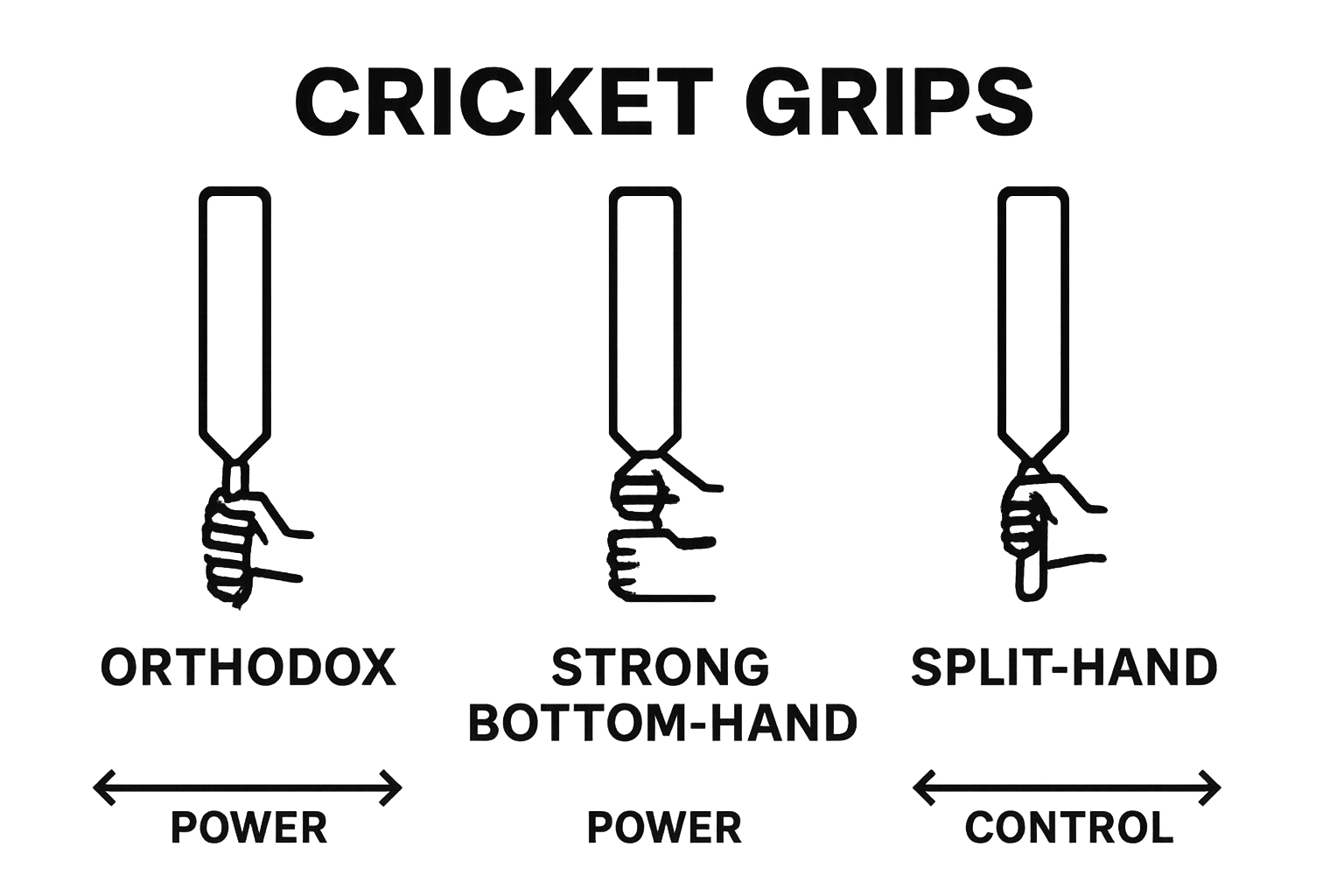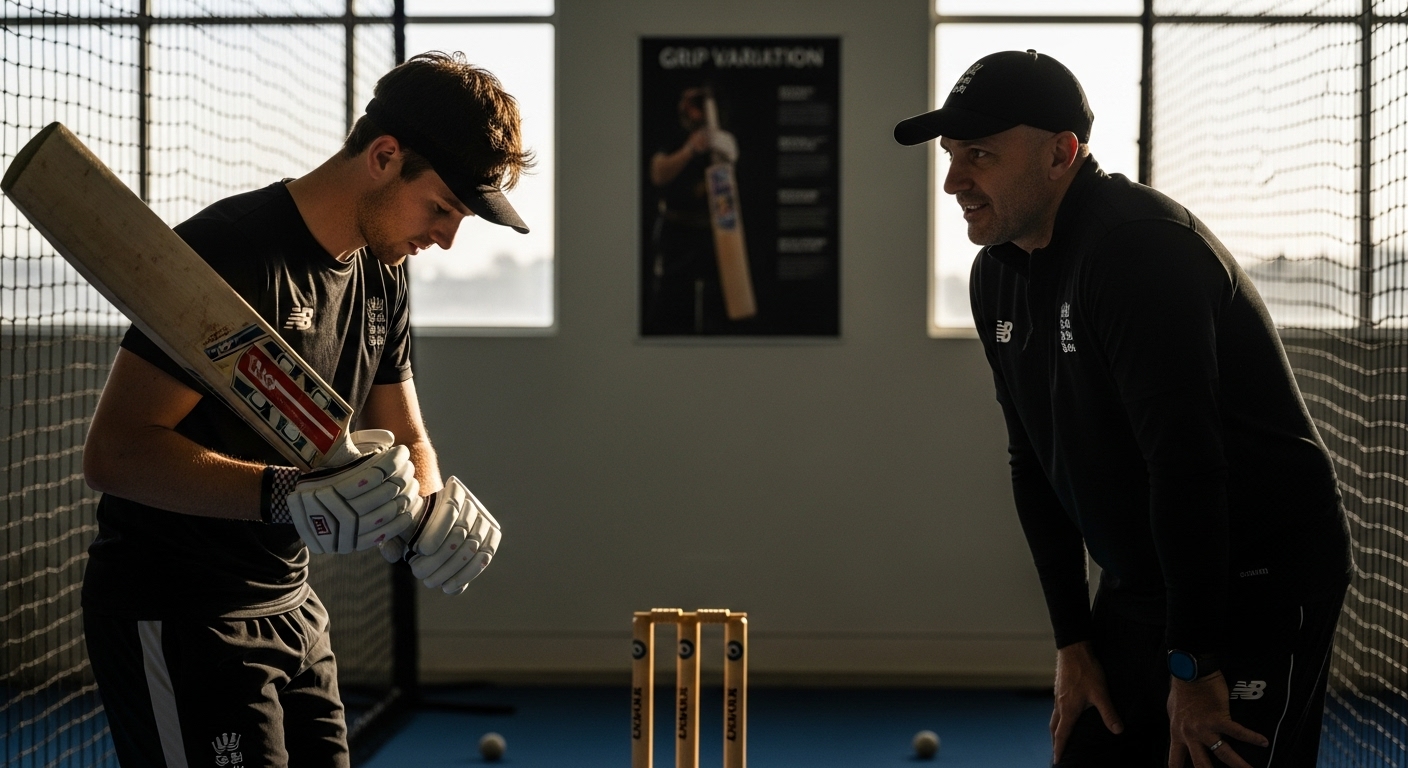Understanding What is a Cricket Grip: Explained Simply

Every serious cricketer knows that the way you hold the bat can change everything on the field. Most people talk about power or hand speed, but here is something wild. Professional batsmen can adjust their grip microseconds before a ball is bowled, unlocking new shot strategies on the fly. The twist is that those tiny grip changes can make the difference between a world-class play and a lost opportunity.
Table of Contents
- What Is A Cricket Grip And Its Role In The Game?
- Why A Proper Cricket Grip Matters For Performance
- How A Cricket Grip Influences Bat Control And Shot Selection
- Key Concepts Of Different Cricket Grips And Their Uses
Quick Summary
| Takeaway | Explanation |
|---|---|
| Proper grip enhances batting performance | A cricket player’s grip affects shot accuracy, power, and overall control during batting. |
| Two main grip styles: orthodox and modified | Each grip style serves different batting strategies and individual comfort preferences. |
| Master grip through practice and adjustments | Consistent training helps develop muscle memory and allows players to intuitively adjust their grip. |
| Grip impacts shot selection and response | The grip influences how players adapt to various bowling styles and pitch conditions effectively. |
| Confidence stems from a solid grip | A proper grip not only improves technique but also boosts a batsman’s psychological readiness and focus. |
What is a Cricket Grip and Its Role in the Game?
A cricket grip represents the foundational technique by which a player holds the cricket bat, determining the precision, power, and control of batting performance. According to Britannica’s sports reference, the grip is more than just hand placement it’s a strategic approach that influences every aspect of batting technique.
Understanding the Fundamental Mechanics
The cricket grip involves positioning both hands on the bat handle in a specific manner that allows maximum control and flexibility. Players typically use two primary grip styles: the orthodox or standard grip and the modified grip. Each style offers unique advantages depending on the player’s batting strategy and the type of delivery they are facing.
Key Elements of an Effective Cricket Grip:
- Ensures stable bat control during shots
- Enables quick adjustments to different bowling styles
- Minimizes potential hand and wrist strain
- Maximizes power transfer from hands to bat
Variations and Technical Nuances
Professional cricketers often customize their grip based on personal comfort and playing style. Some players might slightly rotate their hands or adjust finger positioning to create subtle variations that provide competitive advantages. For those interested in developing advanced batting techniques, our guide on teaching beginner cricketers offers comprehensive insights into perfecting grip fundamentals.
Mastering the cricket grip requires consistent practice, understanding of biomechanics, and an appreciation for how minute adjustments can significantly impact batting performance. While technical precision matters, players must also develop muscle memory and intuitive feel through dedicated training and match experience.
Why a Proper Cricket Grip Matters for Performance
A proper cricket grip is not just a technical detail but a critical factor that can make or break a player’s batting performance. Research from the International Cricket Council demonstrates that professional players invest significant time mastering grip techniques because they directly impact shot precision, power generation, and defensive capabilities.
Biomechanical Impact of Grip Technique
The cricket grip acts as a sophisticated interface between the player’s body mechanics and the bat, translating physical movement into controlled batting actions. Incorrect grip positioning can lead to reduced bat speed, compromised shot accuracy, and increased risk of injury. Professional cricketers understand that grip is fundamentally about creating a natural, stable connection between hand and bat.
Critical Performance Factors Influenced by Grip:
- Shot power and momentum transfer
- Bat control and maneuverability
- Ability to play diverse shot types
- Reduced hand and wrist fatigue
- Minimized risk of technical errors
Psychological and Technical Confidence
Beyond physical mechanics, a proper grip provides psychological reassurance. When batsmen feel confident in their hand positioning, they can focus more on reading the bowler, anticipating deliveries, and making split-second strategic decisions. Explore our guide on batting gloves for enhanced grip performance to understand how equipment complements technique.
Ultimately, developing an exceptional cricket grip is a nuanced journey of continuous learning. It requires patience, practice, and a willingness to make minute adjustments that can transform average performance into extraordinary batting prowess. Professional players spend years refining their grip, understanding that this fundamental skill is the foundation of cricket batting excellence.
The table below outlines how a proper cricket grip directly affects various factors of batting performance, consolidating key points from the article for quick reference.
| Performance Factor | Impact of Proper Grip |
|---|---|
| Shot Accuracy | Increases ability to control direction and timing |
| Power Generation | Maximizes force transfer from hands to bat |
| Shot Selection Flexibility | Enhances adjustment to different bowling styles and pitches |
| Bat Control | Ensures stability and maneuverability |
| Injury Prevention | Reduces hand and wrist strain |
| Technical Confidence | Boosts psychological readiness and focus |
How a Cricket Grip Influences Bat Control and Shot Selection
Research from sports biomechanics reveals that a cricket grip is far more than a simple hand placement technique it’s a sophisticated mechanism that directly influences a player’s ability to control the bat and execute strategic shots. The nuanced relationship between grip and performance represents a critical aspect of batting excellence.
Precision and Adaptive Mechanics
A player’s grip determines their capacity to modify bat angle, speed, and trajectory instantaneously. Different grip variations enable cricketers to respond to varied bowling styles, pitch conditions, and strategic game requirements. Professional batsmen can adjust their grip microseconds before contact, transforming potential defensive shots into aggressive scoring opportunities.
Key Shot Selection Parameters Influenced by Grip:
- Ability to play front foot and back foot shots
- Capacity to adjust bat face angle rapidly
- Control over shot power and direction
- Responsiveness to different bowling speeds
- Minimizing risk of mistimed or unintended shots
Technical Adaptation and Strategic Flexibility
The grip serves as a player’s primary interface with the bat, acting like a dynamic communication channel between physical intention and mechanical execution. Some cricketers develop multiple grip variations to counter specific bowling techniques. For players looking to enhance their bat selection strategy, our comprehensive guide offers insights into choosing the right cricket bat can provide additional technical understanding.
Mastering grip mechanics requires continuous practice, body awareness, and an intuitive understanding of how minute hand adjustments can dramatically alter batting performance. Elite cricketers invest substantial time developing muscle memory and grip flexibility, recognizing that technical proficiency emerges from thousands of repetitive, intentional practice sessions.
Key Concepts of Different Cricket Grips and Their Uses
According to Britannica’s sports reference, cricket grips are sophisticated techniques that extend far beyond basic hand positioning. Each grip variation represents a strategic approach designed to optimize batting performance under diverse playing conditions.
Below is a comparison table summarizing the key types of cricket grips discussed in the article, along with their defining features and common batting uses.
| Grip Type | Description | Typical Uses |
|---|---|---|
| Orthodox (Standard) Grip | Hands close together, balanced control and flexibility | General batting, most shot types |
| Strong Bottom-Hand Grip | Emphasizes bottom hand for added power | Powerful horizontal bat shots |
| Split-Hand Grip | Hands slightly apart for precision and shot manipulation | Intricate or advanced shot-making |
| Open Face Grip | Bat face more open, hands adjusted for finesse shots | Playing soft hands, guiding the ball |
| Closed Face Grip | Bat face more closed, helps keep ball on the ground | Defensive play, preventing aerial shots |

Orthodox and Specialized Grip Techniques
The standard cricket grip, known as the orthodox grip, forms the foundational technique for most batting scenarios. Professional cricketers understand that grip selection is a dynamic skill requiring adaptability and precise muscle control. This grip involves positioning hands close together on the bat handle, providing balanced control and enabling a wide range of shot types.
Primary Cricket Grip Categories:
- Orthodox (Standard) Grip
- Strong Bottom-Hand Grip
- Split-Hand Grip
- Open Face Grip
- Closed Face Grip
Strategic Grip Adaptations
Advanced players develop nuanced grip variations to counter specific bowling challenges. A strong bottom-hand grip, for instance, allows batsmen to generate additional power for horizontal bat shots, while a split-hand grip enables more intricate shot manipulation. For players interested in advanced batting technologies, our guide explores cutting-edge cricket bat metrics that complement grip techniques.
Mastering multiple grip techniques requires extensive practice, body awareness, and an intuitive understanding of how microscopic hand adjustments can transform batting effectiveness. Elite cricketers invest significant time developing muscle memory, recognizing that technical versatility emerges from thousands of intentional, focused practice sessions.

Ready to Master Your Cricket Grip? Step Up with Better Gear and Expert Support
Are you tired of struggling with unreliable bat control, inconsistent shot power, or hand fatigue just because the basics of your cricket grip do not match your playing style? CricketKingdom.co.uk understands how small grip issues hold back even the most passionate players. You have learned that mastering the cricket grip is key for precision and confidence. Now is the moment to bring that knowledge into action with professional-grade equipment and expert support.

Shop at CricketKingdom.co.uk to discover our full range of cricket bats, batting gloves, and personalized gear for players committed to skill progression. Take advantage of exclusive offers like free bat oiling and knocking on select bats, or free shipping when you order over £100. Elevate your technique today and see real change in your batting game. Visit us now to find what gives you the edge.
Frequently Asked Questions
What is a cricket grip?
A cricket grip is the technique used by players to hold the cricket bat, which impacts their ability to control shots, generate power, and perform effectively while batting.
Why is a proper cricket grip important for performance?
A proper cricket grip ensures stable bat control, enhances shot precision, allows for quick adjustments to different bowling styles, and minimizes the risk of injury or technical errors.
What are the main types of cricket grips?
The main types of cricket grips include the orthodox (standard) grip, strong bottom-hand grip, split-hand grip, open face grip, and closed face grip, each serving specific batting needs and strategies.
How can I improve my cricket grip technique?
Improving your cricket grip technique involves consistent practice, understanding the mechanics of grip variations, and developing muscle memory through intentional training and match experience.
Recommended
- How to Teach Beginner Cricketers to Play Straight
- Shop Batting Gloves Online in the UK | The Cricket Kingdom
- The Science of Sensor-Equipped Cricket Bats | The Cricket Kingdom
- How to Choose Cricket Bat: A Step-by-Step Guide for Players – The Cricket Kingdom


